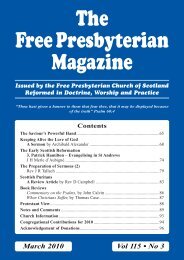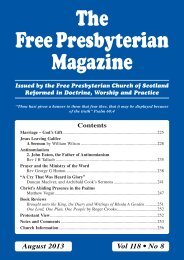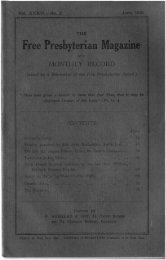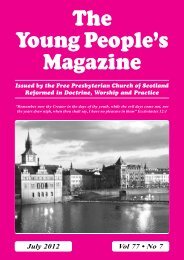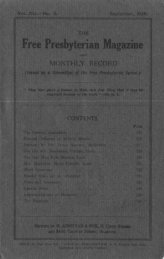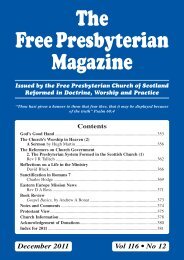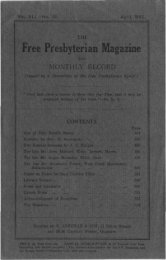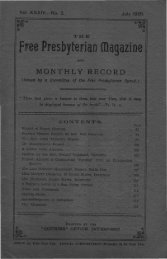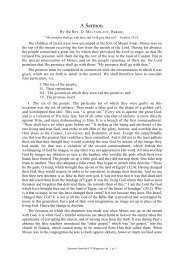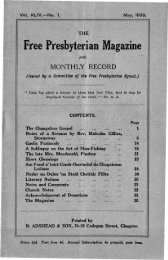April - the Free Presbyterian church of Scotland
April - the Free Presbyterian church of Scotland
April - the Free Presbyterian church of Scotland
You also want an ePaper? Increase the reach of your titles
YUMPU automatically turns print PDFs into web optimized ePapers that Google loves.
Some Steps in Offering Sacrifice 115respondence between this fact and <strong>the</strong> mode in which <strong>the</strong> Saviour died. TheLord was not to meet His death in any o<strong>the</strong>r way but by violence. The sinner’shand was to be <strong>the</strong> instrument <strong>of</strong> inflicting <strong>the</strong> death, even as <strong>the</strong>sinner’s guilt was <strong>the</strong> meritorious cause, and <strong>the</strong> only assignable cause, whydeath could come to Him at all.Still fur<strong>the</strong>r, <strong>the</strong> death was penal. This is to be strictly maintained; as <strong>the</strong>notion that <strong>the</strong> death was only in order to obtain <strong>the</strong> blood – a mere meansto an end and without fur<strong>the</strong>r significance – would perplex and unsettle <strong>the</strong>entire ritual. The death in itself was punitive, <strong>the</strong> wages <strong>of</strong> sin. If not, whatcould <strong>the</strong> blood have accomplished? But on <strong>the</strong> principle that <strong>the</strong> imputation<strong>of</strong> guilt was signified by <strong>the</strong> laying on <strong>of</strong> hands, death followed as <strong>the</strong> necessaryeffect; for <strong>the</strong> worshipper owed death, and <strong>the</strong> infliction <strong>of</strong> it was penal.This excludes <strong>the</strong> subjective <strong>the</strong>ory, which has been contrived by <strong>the</strong> opponents<strong>of</strong> vicarious satisfaction to explain <strong>the</strong> death <strong>of</strong> <strong>the</strong> victim. ThusBahr, with those who follow in his tendency, will have it mean that <strong>the</strong> selfseekinglife <strong>of</strong> man dies, and is replaced by a spiritual life devoted to God.According to this notion, <strong>the</strong> death <strong>of</strong> <strong>the</strong> animal, in its symbolical meaning,teaches <strong>the</strong> mortification <strong>of</strong> sin, that self must be sacrificed. On every groundthis exposition is untenable. Not to mention that it is out <strong>of</strong> keeping with <strong>the</strong>ritual, according to which <strong>the</strong> animal died and continued dead, it takes forgranted that a guilty man can, without any reparation, dedicate himself toGod. But that cannot be, as he has no power to dispose <strong>of</strong> a forfeited life;and without atonement, or covering, for his soul he cannot be dedicated toGod. There is no possibility <strong>of</strong> this without expiation, for death is <strong>the</strong> wages<strong>of</strong> sin.4. The next act in <strong>the</strong> sacrificial ritual was <strong>the</strong> sprinkling <strong>of</strong> <strong>the</strong> blood. Atthis point <strong>the</strong> priest’s activity commenced. He had been, up to this step in <strong>the</strong>ritual, present as a spectator, but he now steps in to take part in it. It was hewho received <strong>the</strong> flowing blood <strong>of</strong> <strong>the</strong> animal and who put it on <strong>the</strong> horns,or highest point, <strong>of</strong> <strong>the</strong> altar, and who poured it out at <strong>the</strong> bottom (Lev 4:25-34), an action which intimated that <strong>the</strong> meeting-place between God andHis people was from top to bottom covered with blood, that <strong>the</strong> sins <strong>of</strong> <strong>the</strong>people were covered by an atonement, and that <strong>the</strong> worshippers were nomore exposed to His frown.The blood received by <strong>the</strong> priest, and made his own, is regarded as <strong>the</strong>vicariously-shed blood <strong>of</strong> <strong>the</strong> priest. Thus, in <strong>the</strong> ritual, we consider not<strong>the</strong> victim alone but also <strong>the</strong> priest, without whom <strong>the</strong> sacrifice could not beduly <strong>of</strong>fered. The action <strong>of</strong> receiving <strong>the</strong> blood had a special significance: itsignified that he made <strong>the</strong> blood his own. Besides, <strong>the</strong> washings, vestmentsand o<strong>the</strong>r typical sanctifications shadowed forth <strong>the</strong> holiness and righteous-



